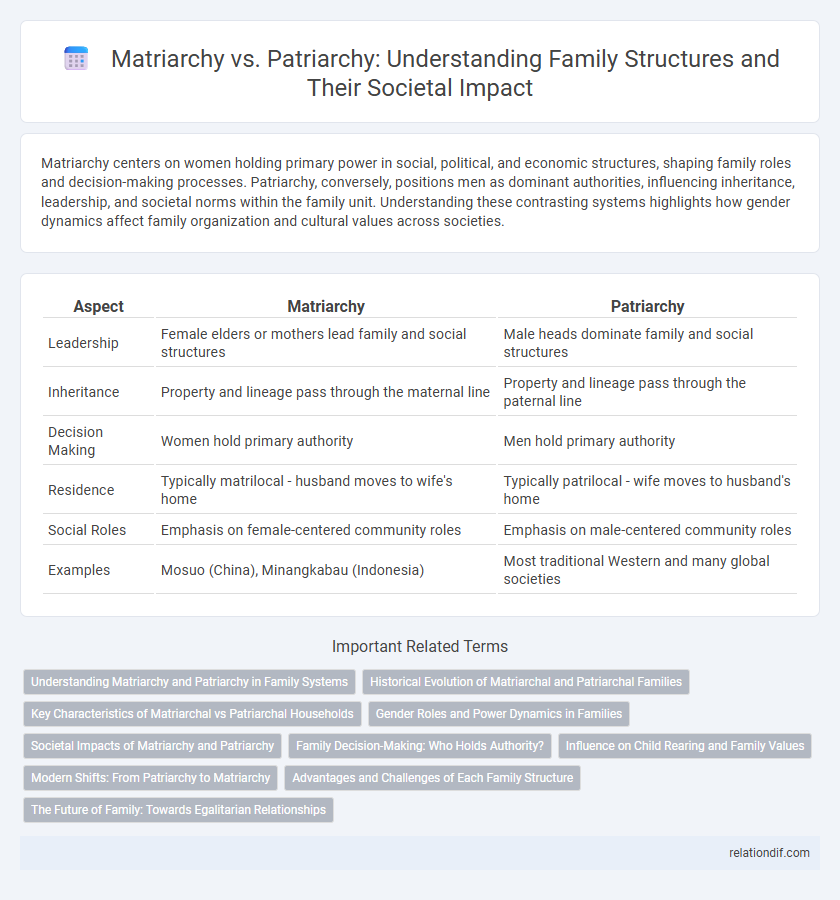Matriarchy centers on women holding primary power in social, political, and economic structures, shaping family roles and decision-making processes. Patriarchy, conversely, positions men as dominant authorities, influencing inheritance, leadership, and societal norms within the family unit. Understanding these contrasting systems highlights how gender dynamics affect family organization and cultural values across societies.
Table of Comparison
| Aspect | Matriarchy | Patriarchy |
|---|---|---|
| Leadership | Female elders or mothers lead family and social structures | Male heads dominate family and social structures |
| Inheritance | Property and lineage pass through the maternal line | Property and lineage pass through the paternal line |
| Decision Making | Women hold primary authority | Men hold primary authority |
| Residence | Typically matrilocal - husband moves to wife's home | Typically patrilocal - wife moves to husband's home |
| Social Roles | Emphasis on female-centered community roles | Emphasis on male-centered community roles |
| Examples | Mosuo (China), Minangkabau (Indonesia) | Most traditional Western and many global societies |
Understanding Matriarchy and Patriarchy in Family Systems
Matriarchy and patriarchy represent two distinct family systems characterized by female and male authority, respectively. In matriarchal families, lineage, inheritance, and decision-making power are traced through the mother's line, promoting female leadership and communal responsibilities. Patriarchal families emphasize male dominance in social, economic, and familial roles, often reinforcing hierarchical structures based on gender.
Historical Evolution of Matriarchal and Patriarchal Families
Matriarchal families, prominent in prehistoric societies, centered on female authority and lineage, often associated with communal land ownership and maternal inheritance systems. In contrast, patriarchal families emerged with the advent of agriculture and state formation, emphasizing male dominance, patrilineal descent, and centralized property control. Historical evolution reveals a complex shift influenced by economic, social, and religious factors shaping family structures over millennia.
Key Characteristics of Matriarchal vs Patriarchal Households
Matriarchal households are characterized by female leadership, where decision-making authority and inheritance pass through the maternal line, promoting communal care and emotional bonds. Patriarchal households emphasize male authority, with lineage and property typically traced through males, fostering hierarchical structures and defined gender roles. These key differences shape family dynamics, social obligations, and power distributions within the household.
Gender Roles and Power Dynamics in Families
Matriarchy and patriarchy shape gender roles and power dynamics in families by defining authority and decision-making patterns, with matriarchal systems often emphasizing female leadership and nurturing responsibilities. Patriarchal families typically assign dominant roles to men, reinforcing male authority and control over resources and social status. These structures influence the distribution of labor, emotional support, and inheritance, impacting family cohesion and individual identity.
Societal Impacts of Matriarchy and Patriarchy
Matriarchy often fosters community cohesion and emphasizes collective well-being, promoting gender equality and nurturing social support networks. Patriarchy typically reinforces hierarchical structures, prioritizing male authority and influencing societal norms that affect gender roles, power distribution, and economic opportunities. These contrasting systems shape social policies, family dynamics, and intergenerational relationships, significantly impacting cultural development and social stability.
Family Decision-Making: Who Holds Authority?
In family decision-making, matriarchal systems often centralize authority with the mother or eldest female, influencing daily management and significant choices such as education and finances. Patriarchal families typically vest decision-making power in the father or eldest male, controlling legal, financial, and social matters. Studies reveal matriarchal authority fosters collaborative communication, whereas patriarchal dominance may prioritize hierarchical structure in family governance.
Influence on Child Rearing and Family Values
Matriarchy often emphasizes communal child-rearing practices and nurtures emotional openness, fostering strong interpersonal bonds and collaborative family values. Patriarchy typically centers on hierarchical authority with fathers as primary decision-makers, promoting discipline and tradition within child-rearing approaches. These differing power dynamics shape children's social development and internalization of family roles, impacting future generational behavior and cultural continuity.
Modern Shifts: From Patriarchy to Matriarchy
Modern shifts from patriarchy to matriarchy reflect changing family dynamics where women increasingly hold leadership roles in households and communities, influencing decision-making and resource allocation. These transformations are driven by social movements advocating gender equality, economic empowerment of women, and evolving cultural norms that challenge traditional male dominance. Emerging matriarchal models emphasize collaboration, nurturing roles, and shared responsibilities, reshaping modern family structures and power distribution.
Advantages and Challenges of Each Family Structure
Matriarchal families often benefit from strong female leadership that fosters communal decision-making and emotional support, promoting resilience and cooperation; however, challenges include potential power imbalances and societal marginalization in patriarchal-dominated cultures. Patriarchal families provide clear hierarchical structures that may enhance order and economic stability, but often face difficulties such as limited emotional expression and gender role rigidity, which can hinder personal growth and equality. Each system's effectiveness depends on cultural context, flexibility in roles, and the ability to adapt to modern social dynamics.
The Future of Family: Towards Egalitarian Relationships
Matriarchy and patriarchy have historically shaped family dynamics, but the future points towards egalitarian relationships that promote shared decision-making and equal responsibility between partners. Research shows that families embracing gender equality experience higher levels of emotional well-being and stronger child development outcomes. Shifting cultural norms and policies supporting work-life balance play a crucial role in fostering these balanced family structures.
matriarchy vs patriarchy Infographic

 relationdif.com
relationdif.com